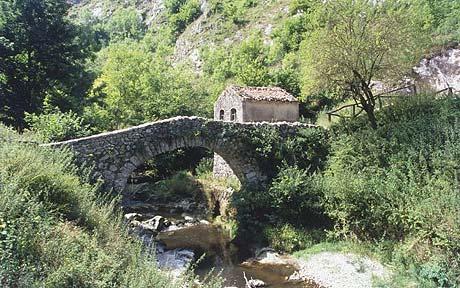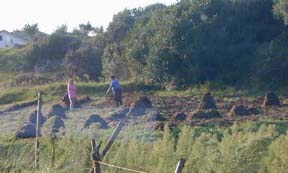Green Spain
Northern Spain, or Green Spain,
is not usually where the tourists go, and certainly not where
most people choose to buy property. This could be a mistake,
but I suppose it depends on what you want to find.
The sea, and indeed the weather, is not so hot as it is down on the Costa del Sol. There is more rain, and the countryside is more like green England.

There are the Picos de Europa, which are steep and rugged, and have snow on them during the winter, and of course the Pyrenees are not far away.
The bays and charming little coves are really sweet, and I would certainly recommend the area for a holiday expedition.
Cantabria is the name given to the strip of land between the Cantabrian Sea, otherwise known as the Bay of Biscay, and the Cantabrian Mountains in northern Spain.
Biscay is a corruption of the Spanish word Vizcaya, meaning a mountain or cliff, and probably relates to the way the Picos de Europa dominate the northern coast of Spain facing the bay.
Following the collapse of the Roman Empire, Cantabria regained its independence from the rule of the Visigoths, and remained independent until the Arab invasion. In the year 714, a mixed Arab/Barber army invaded the upper valleys of the Ebro and succeeded in capturing Amaya, then the Cantabrian capital. However, they did not get beyond the mountains, and this strip of Spain was the one area the moors did not manage to settle.
When I last travelled along this northern coastline with Julie we stopped in the little town of Castro Urdiales, which is Roman in origin and was originally called Portus Amanus. In AD 74 a Roman colony was established under the name Flaviobriga, during the reign of Vespasian, probably to mine the abundant iron ore in the area.
The chief industries now are mining, fishing, and the preservation of fish in oil, especially sardines and anchovies.
Many people from Bilbao and other parts of the Basque Country and Cantabria as well as Northern Spain in general keep summer homes in the town.
By its name I assumed it was an old Roman town. The centre is certainly old, but not much of the very old is left. There is a charming small inner harbour filled with the usual bobbing boats, but one or two of the ancient houses in the suburbs are rather fine villas.
All along the north coast of Cantabria are the foothills of the Picos de Europa, covered in lush green, with small valleys funnelling into the sea; small inlets where the sea brushes in beside the hills, and, as it retreats, leaves a bank of sand overshadowed by woodland clinging to the steep sides of the hills.
Inlet after inlet cuts the coastline. Here and there are villages, usually set back from the coast behind a rise in the land for protection from the winter winds. Farmers are cutting small patches of grass. Behind are wife and children with rakes, collecting the new-mown grass into rows, and then into small domes.

Down on the beach another farmer is raking up the seaweed left by the retreating tide and bundling it into a cart. The tractor tows the cart up a perilous track, and the seaweed is dumped in what look like giant molehills on the fields as fertilizer. This is then spread slowly with a long-handled rake wielded by a farm-hand with a bent back.
Further along the coast is a large valley where the river runs from tiny stream to estuary over the space of half a mile. Set in behind the trees, and in amongst the folds in the rock, are secret houses.
The sun is shining, the beaches are empty, the leaves glisten with the drops from yesterday's rain, the fields are green, there are cows with massive horns, farmers are tilling tiny plots, and up in the sky a few white clouds define the clear pale blue.
Further west are the high mountains of the Picos de Europa, with snow shining on them. The mountains are a jagged lot, and all around them are the lesser mounds of the Cantabrian mountain range, which seems to stretch almost from the Pyrenees to the edge of Asturias. To the north is the blue calm sea, and dozens of little bays. For every steep valley that cuts into the foothills, there is a small rushing stream tumbling down the rocks and fanning out onto a small flat lea before being claimed by the waves toppling onto a crescent sandy beach.
The sea, and indeed the weather, is not so hot as it is down on the Costa del Sol. There is more rain, and the countryside is more like green England.

There are the Picos de Europa, which are steep and rugged, and have snow on them during the winter, and of course the Pyrenees are not far away.
The bays and charming little coves are really sweet, and I would certainly recommend the area for a holiday expedition.
Cantabria is the name given to the strip of land between the Cantabrian Sea, otherwise known as the Bay of Biscay, and the Cantabrian Mountains in northern Spain.
Biscay is a corruption of the Spanish word Vizcaya, meaning a mountain or cliff, and probably relates to the way the Picos de Europa dominate the northern coast of Spain facing the bay.
Following the collapse of the Roman Empire, Cantabria regained its independence from the rule of the Visigoths, and remained independent until the Arab invasion. In the year 714, a mixed Arab/Barber army invaded the upper valleys of the Ebro and succeeded in capturing Amaya, then the Cantabrian capital. However, they did not get beyond the mountains, and this strip of Spain was the one area the moors did not manage to settle.
When I last travelled along this northern coastline with Julie we stopped in the little town of Castro Urdiales, which is Roman in origin and was originally called Portus Amanus. In AD 74 a Roman colony was established under the name Flaviobriga, during the reign of Vespasian, probably to mine the abundant iron ore in the area.
The chief industries now are mining, fishing, and the preservation of fish in oil, especially sardines and anchovies.
Many people from Bilbao and other parts of the Basque Country and Cantabria as well as Northern Spain in general keep summer homes in the town.
By its name I assumed it was an old Roman town. The centre is certainly old, but not much of the very old is left. There is a charming small inner harbour filled with the usual bobbing boats, but one or two of the ancient houses in the suburbs are rather fine villas.
All along the north coast of Cantabria are the foothills of the Picos de Europa, covered in lush green, with small valleys funnelling into the sea; small inlets where the sea brushes in beside the hills, and, as it retreats, leaves a bank of sand overshadowed by woodland clinging to the steep sides of the hills.
Inlet after inlet cuts the coastline. Here and there are villages, usually set back from the coast behind a rise in the land for protection from the winter winds. Farmers are cutting small patches of grass. Behind are wife and children with rakes, collecting the new-mown grass into rows, and then into small domes.

Down on the beach another farmer is raking up the seaweed left by the retreating tide and bundling it into a cart. The tractor tows the cart up a perilous track, and the seaweed is dumped in what look like giant molehills on the fields as fertilizer. This is then spread slowly with a long-handled rake wielded by a farm-hand with a bent back.
Further along the coast is a large valley where the river runs from tiny stream to estuary over the space of half a mile. Set in behind the trees, and in amongst the folds in the rock, are secret houses.
The sun is shining, the beaches are empty, the leaves glisten with the drops from yesterday's rain, the fields are green, there are cows with massive horns, farmers are tilling tiny plots, and up in the sky a few white clouds define the clear pale blue.
Further west are the high mountains of the Picos de Europa, with snow shining on them. The mountains are a jagged lot, and all around them are the lesser mounds of the Cantabrian mountain range, which seems to stretch almost from the Pyrenees to the edge of Asturias. To the north is the blue calm sea, and dozens of little bays. For every steep valley that cuts into the foothills, there is a small rushing stream tumbling down the rocks and fanning out onto a small flat lea before being claimed by the waves toppling onto a crescent sandy beach.
|
Subscribe
to our email alerts on the housing markets both
in the UK and abroad.
|
HTML Comment Box is
loading comments...
Podcasts: